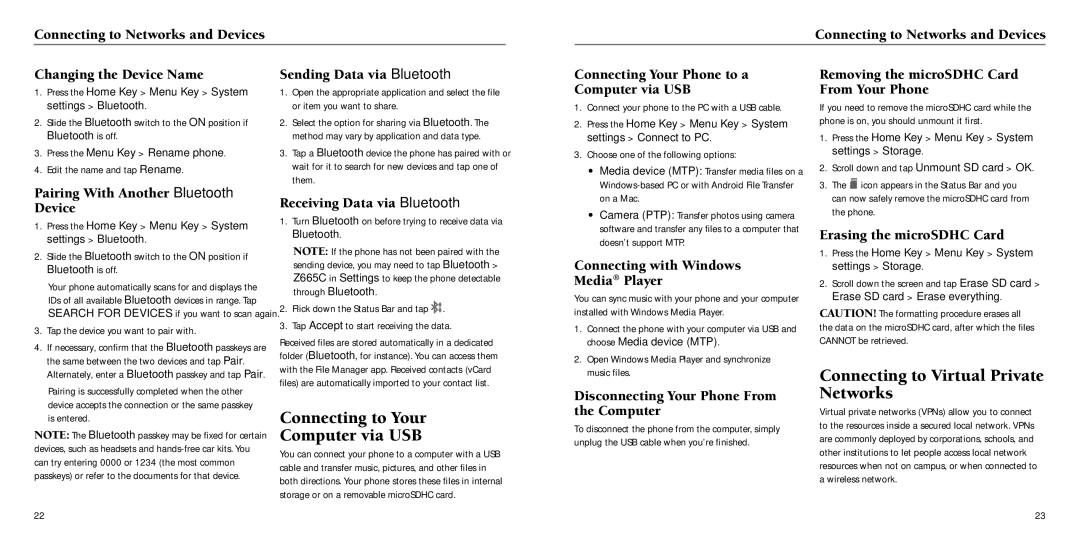Connecting to Networks and Devices
Connecting to Networks and Devices
Changing the Device Name
1.Press the Home Key > Menu Key > System settings > Bluetooth.
2.Slide the Bluetooth switch to the ON position if Bluetooth is off.
3.Press the Menu Key > Rename phone.
4.Edit the name and tap Rename.
Pairing With Another Bluetooth Device
1.Press the Home Key > Menu Key > System settings > Bluetooth.
2.Slide the Bluetooth switch to the ON position if Bluetooth is off.
Your phone automatically scans for and displays the IDs of all available Bluetooth devices in range. Tap SEARCH FOR DEVICES if you want to scan again.
3.Tap the device you want to pair with.
4.If necessary, confirm that the Bluetooth passkeys are the same between the two devices and tap Pair. Alternately, enter a Bluetooth passkey and tap Pair.
Pairing is successfully completed when the other device accepts the connection or the same passkey is entered.
NOTE: The Bluetooth passkey may be fixed for certain devices, such as headsets and
Sending Data via Bluetooth
1.Open the appropriate application and select the file or item you want to share.
2.Select the option for sharing via Bluetooth. The method may vary by application and data type.
3.Tap a Bluetooth device the phone has paired with or wait for it to search for new devices and tap one of them.
Receiving Data via Bluetooth
1.Turn Bluetooth on before trying to receive data via Bluetooth.
NOTE: If the phone has not been paired with the sending device, you may need to tap Bluetooth > Z665C in Settings to keep the phone detectable through Bluetooth.
2.Flick down the Status Bar and tap ![]() .
.
3.Tap Accept to start receiving the data.
Received files are stored automatically in a dedicated folder (Bluetooth, for instance). You can access them with the File Manager app. Received contacts (vCard files) are automatically imported to your contact list.
Connecting to Your
Computer via USB
You can connect your phone to a computer with a USB cable and transfer music, pictures, and other files in both directions. Your phone stores these files in internal storage or on a removable microSDHC card.
Connecting Your Phone to a Computer via USB
1.Connect your phone to the PC with a USB cable.
2.Press the Home Key > Menu Key > System settings > Connect to PC.
3.Choose one of the following options:
•Media device (MTP): Transfer media files on a
•Camera (PTP): Transfer photos using camera software and transfer any files to a computer that doesn’t support MTP.
Connecting with Windows
Media® Player
You can sync music with your phone and your computer installed with Windows Media Player.
1.Connect the phone with your computer via USB and choose Media device (MTP).
2.Open Windows Media Player and synchronize music files.
Disconnecting Your Phone From the Computer
To disconnect the phone from the computer, simply unplug the USB cable when you’re finished.
Removing the microSDHC Card From Your Phone
If you need to remove the microSDHC card while the phone is on, you should unmount it first.
1.Press the Home Key > Menu Key > System settings > Storage.
2.Scroll down and tap Unmount SD card > OK.
3.The ![]() icon appears in the Status Bar and you can now safely remove the microSDHC card from the phone.
icon appears in the Status Bar and you can now safely remove the microSDHC card from the phone.
Erasing the microSDHC Card
1.Press the Home Key > Menu Key > System settings > Storage.
2.Scroll down the screen and tap Erase SD card > Erase SD card > Erase everything.
CAUTION! The formatting procedure erases all the data on the microSDHC card, after which the files CANNOT be retrieved.
Connecting to Virtual Private Networks
Virtual private networks (VPNs) allow you to connect to the resources inside a secured local network. VPNs are commonly deployed by corporations, schools, and other institutions to let people access local network resources when not on campus, or when connected to a wireless network.
22
23
